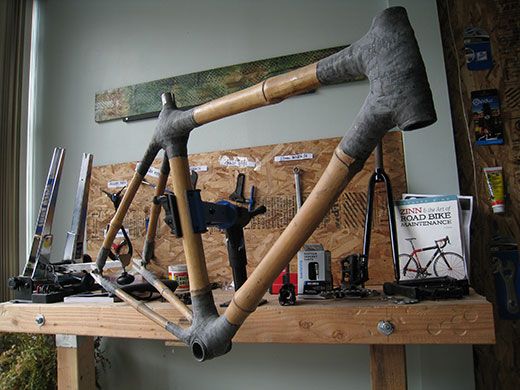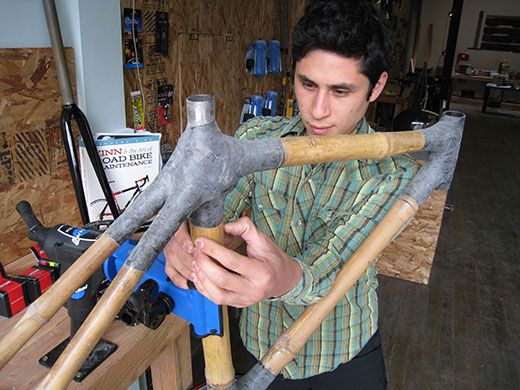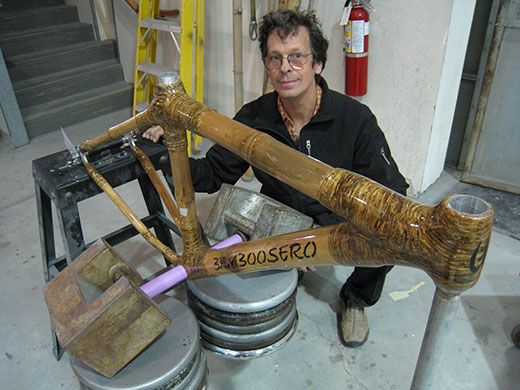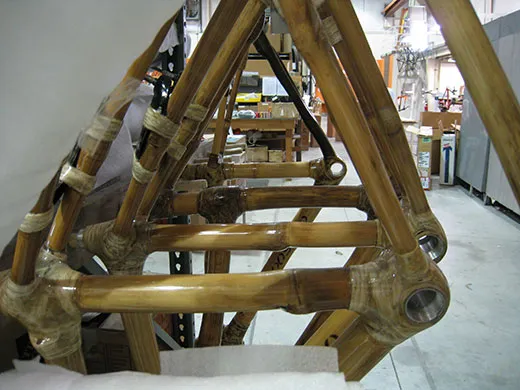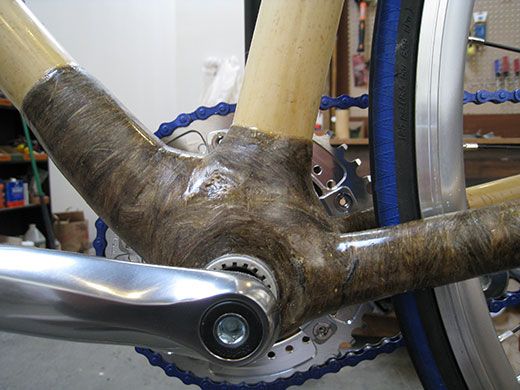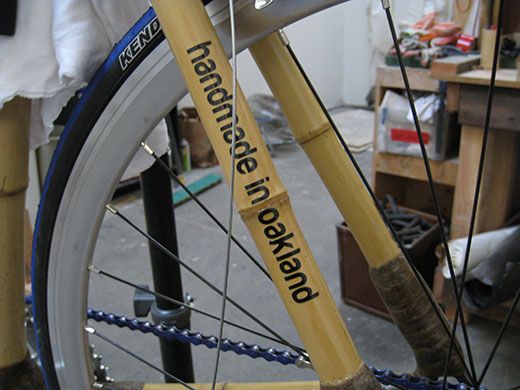Turning Bamboo Into a Bicycle
A cycling entrepreneur has turned to the durable plant as a low-tech and affordable option for building bikes
/https://tf-cmsv2-smithsonianmag-media.s3.amazonaws.com/filer/bamboo-bikes-Craig-Calfee-631.jpg)
Bicycle designer Craig Calfee likes to talk about the time a film crew tried to stress-test one of his bamboo bike frames. Three men—each weighing about 200 pounds—piled onto one of the two-wheelers in his California showroom, and off they went. The ride didn’t last very long.
“The bamboo frame held up just fine,” Calfee recalls with a grin. “But the wheels collapsed.“ For the next test, Calfee supplemented the wheels’ metal spokes with bamboo struts: Problem solved.
Calfee, 49, grew up in Cape Cod. He worked as a bike messenger while attending the Pratt Institute in Brooklyn, and helped fabricate Olympic-class kayaks in the mid-1980s. Those two experiences synergized into designing and building carbon fiber bicycle frames. In 1991, with the support of three-time champion Greg LeMond, he built the first all-carbon bicycles to compete in the Tour de France.
Dressed in a casual black jacket and aviator shades, Calfee looks more like a biker than a bicycle builder. Today, his workshop in La Selva Beach assembles some of the most advanced carbon fiber racing bicycles in the world. But Calfee also focuses his attention on a lower-tech material: bamboo.
Bamboo: Stronger Than You Might Think
“One afternoon, in 1995, my dog Luna and I started playing with a bamboo stick. I was sure it would break, or splinter—but it didn’t. I’d never realized how strong bamboo was. It inspired me, and I built my first bamboo bike as a gimmick for a trade show.”
“Where is it now?”
“At my house,” Calfee says. “I’m riding it still.”
Bamboo is not just strong; it’s also durable, attractive and sustainable. In recent years, the widely adaptable plant—actually a fast-growing member of the grass family (Poaceae)—has provided the raw material for everything from fishing poles to bedsheets. Bicycle frames, traditionally made of welded metal tubes, are an innovative use for this plentiful resource (though not exactly new: the first bamboo bike was built in England, in 1894).
Bamboo’s secret lies in its woody fiber. Microscopic tubes in the culm (stem), called vascular bundles, give the plant a strength comparable to light steel. Weight-wise (at the same stiffness) it’s also similar to steel—though considerably heavier than carbon.
Bamboo bike frames are assembled in two steps. First, the heat-treated poles are measured, cut and mitered together. Then—since welding isn’t possible—the joints are wrapped with fiber. Calfee uses hemp, or other natural fibers, soaked in epoxy. When the epoxy sets, the joints are virtually indestructible.
“What a bamboo frame has that all other bicycle frame materials lack,” Calfee observes, “is vibration damping. Bamboo wins heads and shoulders above everything else for smoothness and absorbing vibration—both of which contribute to a comfortable ride.”
A ride along the coastal bluffs bears this out. The path is packed dirt, rutted by the recent rains. But the ride never feels stiff or jarring. A hundred yards west, the Pacific Ocean froths with whitecaps. I feel at one with the bamboo frame beneath me: a comfortable blend of state-of-the-art and Flintstones technology.
Along with their artisan appeal, the availability of bamboo makes these bikes an ideal cottage industry for the developing world. Calfee is tapping into this potential. His signature bikes, made in California, run upwards of $3,500. But he also directs a project called Bamboosero, based in Ghana and Uganda.
“During the early 1980s I traveled across Africa and had a bit of experience with the continent. Years later, Columbia University’s Earth Institute approached me to do a bamboo bike project. Ghana kept coming up as a place that had a lot of village bicycle projects, designed to train local mechanics.”
Though Calfee eventually parted ways with the Institute—he prefers smaller operations, while they plan a large-scale bike factory—Bamboosero continues to thrive. The assembled frames, shipped back to California for inspection and hardware, sell for around $700.
Do It Yourself Bike Building
Building with bamboo presents daunting challenges. Unlike steel or carbon, you can’t just order tubes to precise specifications.
“It’s inconsistent in shape, size, thickness and diameter,” notes Lars Jacobsen, a co-founder of Stalk Bicycles in Oakland, California. “And dependability. If you’re building these things, you can’t just jump in headlong. It takes a lot of experience with the material to see what’s going to work and what’s not.”
Jacobsen, 25, is at the point where he uses these quirks to his advantage. When I visit the Stalk workshop, Lars is building a bike for his brother. The frame bars look a bit wavy, but Lars reassures me. “Bamboo grows wobbly,” he reminds me. “And it’s just as strong as when it grows straight. One day, I’ll build the perfect Dr. Seuss bike.”
Stalk handcrafts some 72 bamboo bikes a year, all built to order. And while Calfee and Bamboosero source their bamboo from Taiwan and Africa, Stalk buys mainly within California.
“Right now,” Jacobsen admits, “it’s a niche. But we hope that as sustainability becomes more desirable, bamboo bikes will become more appealing. I’ve sold most of our bikes just by taking mine on public transit. I’m not riding up and down the train car; people approach me. ‘Is that really bamboo? Is it strong? How much does it weigh?’ It really helps us win the perception battle—where we face preconceptions about bamboo being ‘weak’ or ‘primitive.’”
Right now, Stalk charges about $1,500 for a complete, single-speed bicycle. “But we’d like to get that down below $1,000,” says Jacobsen. “Our goal is to make these affordable to more people.”
There are now about half a dozen artisans building bamboo bikes in the United States, including Organic Bikes in Wisconsin, Erba Cycles in Boston, and Renovo in Portland (a wood and bamboo blend). But the cheapest way to get one may be to build it yourself.
The Bamboo Bike Studio, with workshops in Brooklyn and San Francisco, offers hands-on classes where people with no bike-building experience at all can sign up and—for as little as $700—walk out three days later with a completed bamboo bicycle.
“After one woman finished her bike and rode it for the first time, she wept,” recalls co-founder Justin Aguinaldo. “She was amazed to learn she could do something like that.”
“We’ll soon be opening Bamboo Bike Studios in Toronto and Alabama,” says Aguinaldo, whose enthusiasm for the craft is contagious. “We’re also planning a tour, and taking the workshop on the road. There are lots of people who want to build bikes; they just can’t get to a studio. So we want to get to them.”
Also active in Africa, the Bamboo Bike Studio picked up where Calfee left off. Allied with the Earth Institute, it’s helping to launch a factory in Kumasi, Ghana. “If people can buy bikes made locally,” Aguinaldo observes, “they can avoid the higher cost of importing bikes from China.” Their ambitious goal is to turn out some 5,000 each year. The cost? About $75 a bike.
Catching Up on the Industry Leader
In 1991, Craig Calfee predicted that every bicycle in the Tour de France would be made of carbon fiber (they are). Though he doesn’t have the same aspiration for bamboo, he’d like to see the bikes gain wider traction— but that would mean rigorous field testing and quality control. Some early carbon-frame bikes had serious design and construction flaws, which hobbled their acceptance. He hopes bamboo can avoid that pitfall.
“A lot of people think bamboo bikes are easy to make, so there’s quite a few people making them,” Calfee says. “But bikes in general are difficult to build. When you design a structure that can hold a 200 lb. person rolling down a mountain at 40 miles per hour, there’s a lot of risk involved.
“Bamboo bikes are at the early stage of market acceptance, and there have been no disasters yet. But poorly-made bikes will lead to accidents, and the reputation of all bamboo bikes will suffer. I went through that with carbon fiber,” Calfee says, shaking his head. “I don’t want to go through it again.”
